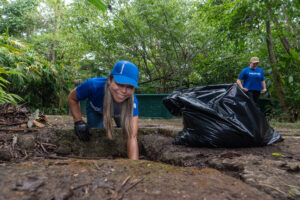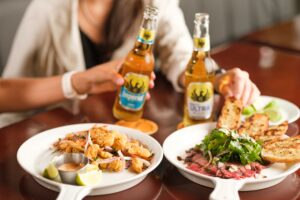- The Urban Eco Connection Project transforms productive spaces into wildlife corridors
- More than 100 species of fauna have been identified on FIFCO’s property thanks to monitoring carried out in conjunction with Universidad Nacional
On World Environment Day, celebrated every June 5, FIFCO celebrates the progress of the Urban Eco Connection Project (ECU), an initiative that transforms the green areas of its production plants in Heredia into climate refuges within the Cubujuquí Interurban Biological Corridor (Cubujuquí IBC). This effort reaffirms the company’s commitment to biodiversity conservation, environmental regeneration, and climate change adaptation.
Since its initial stage in 2024, the project has been developed with the support of biodiversity specialists from the Biology Laboratory of Universidad Nacional (UNA), who conducted an inventory of the fauna present on the company’s property. Twelve species of bats, 9 species of mammals, 70 species of birds, 9 species of reptiles, 6 species of amphibians, and a wide variety of insects were identified. This information establishes a baseline for the subsequent ecological transformation of the space.
“Urban climate refuges have become a nature-based solution to address the effects of extreme events such as heat waves, droughts, or floods. In the case of the ECU Project, in addition to being a point of connectivity in the Cubujuquí IBC, it protects various species, contributes to improving air quality, strengthening ecosystem health, and providing environmental education and awareness opportunities for the community,” explained Karine Steinvorth, Head of Positive Environmental Value at FIFCO.
The ECU Project is directly related to the objectives of FIFCO’s climate strategy by integrating climate change mitigation and adaptation measures. Among its most notable actions are the restoration of the Río Segundo protection area and the creation of themed eco-trails.
“The private sector has a key role to play in the regeneration of urban nature. This project allows us to generate environmental value from our operations, where we can demonstrate that it is possible to produce and conserve nature at the same time, in line with the company’s sustainability and resilience criteria,” added Maria Pía Robles, FIFCO’S Director of Corporate Relations.
In addition to the benefits for wildlife, the project also contributes to the creation of spaces for meeting, well-being, and connection with nature for company employees and neighboring communities. Citizen participation is promoted through volunteer programs, citizen science activities such as bird counts, and environmental education campaigns.
The Cubujuquí IBC, to which the project is connected, covers more than 230 km² and benefits more than 386,000 people. It is estimated that there are more than 300 species of birds, more than 45 species of mammals, 25 species of amphibians, umbrella species such as the tapir, and more than 1,000 species of plants, many of which are endangered.
The ECU Project is currently under development, with progress in the diagnostic, monitoring, and ecological restoration stages. Its implementation is part of FIFCO’s environmental action plan for 2027, reaffirming its commitment to actively contribute to climate resilience and urban biodiversity in Costa Rica. We invite you to learn more about this and other projects in the company’s 2024 Integrated Report, available at fifco.com.


